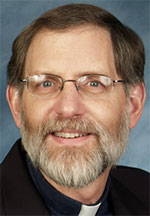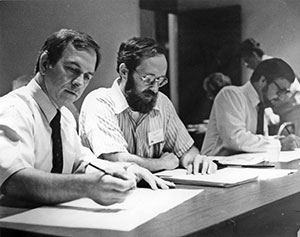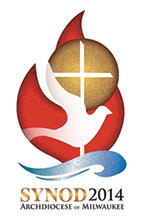When Fr. Donald Thimm was asked in 1985 to direct the 1987 Milwaukee Archdiocesan Synod, he wasn’t sure what a synod was or what it entailed. After all, the last archdiocesan synod had been held in 1892 and was only attended by priests. Few notes or documents remained from that event. Fr. Donald Thimm
Fr. Donald Thimm
Yet, when Fr. Michael Newman, chancellor of the archdiocese, said, “The archbishop would like you to be the synod director,” Fr. Thimm accepted.
“I said, ‘Sure,’ without knowing exactly what it was,” the priest said in a March 14 interview with the Catholic Herald at Holy Apostles Parish, New Berlin, where he has been pastor since 2010.
In 1983, Fr. Thimm was assigned to St. Agnes Parish, Milwaukee, and served on the board of the Central City Catholic School System, while pursuing a doctorate in ministry, specializing in organizational development administration, at the University of St. Mary of the Lake in Mundelein, Ill.
 During the 1987 Archdiocesan Synod, held at the MECCA, these unidentified tabulators did all of their work by hand. At the June 7-8 Archdiocesan Synod, which will be held at the Cousins Center, all tabulations will be done electronically. (Catholic Herald file photo)
During the 1987 Archdiocesan Synod, held at the MECCA, these unidentified tabulators did all of their work by hand. At the June 7-8 Archdiocesan Synod, which will be held at the Cousins Center, all tabulations will be done electronically. (Catholic Herald file photo)
In August 1984, Archbishop Rembert G. Weakland wrote a pastoral letter, “Walking Together: Convoking an archdiocesan synod for fall 1987.” A steering committee, overseen by Fr. Newman and comprised of clergy, religious and lay people, had already begun meeting when Fr. Thimm was appointed. For the next two years, directing the synod was his full-time job.
Learning from voice of experience
A task force exploring the possibility of another Archdiocesan Synod met with Fr. Thimm in December 2011, in order to learn from his experience.
“I told them that the times and the church are different than they were in the mid-‘80s. This whole thing served a particular purpose and a particular need at a particular time in the church,” he told the task force regarding the scope of the ’87 synod. “This was a time when leadership in the church was significantly interested in listening to what people were saying and that to do this and not listen and not respond would not be prudent.”
He told the group the synod was a response to the archbishop’s pastoral letter, and to his vision of gathering the church together.
“I said (to the task force), ‘To do it means you need to be serious about listening and come with a willingness to respond to what is listened; is that what the church is doing these days?’” Fr. Thimm recalled. “This is what we did and it worked, and it really built off of that whole process of responding.”
He noted the Archdiocesan Synod that will be held June 7-8 “has seemed to follow a similar model of sincere listening and conversation and responding to it.”
“It’s about giving it a focus and listening, and what does the archbishop want from this?” Fr. Thimm said in the interview. “Because clearly this all served Archbishop Weakland in his time.”
’87 synod a ‘powerful experience’
Although it has been nearly 27 years since the last synod, Fr. Thimm still encounters people who tell him, “We were in the synod.” He sees that as an indication they were grateful for the experience.
“For us, it was sort of a new thing of the church actually listening and inviting us; it was a great way to bring together the lay, the ordained, the religious, the young and the old and diverse,” he said, noting the diversity reflected Archbishop Weakland’s “vision of church.” “We had never really had that opportunity before so that was a powerful experience.”
Fr. Thimm noted that 1,900 delegates participated in the synod itself, and that another 2,000 to 3,000 attended the closing liturgy.
“I don’t know how common that was in the ‘80s, but for me that was a pretty special thing,” he said.
Referring to a story he had heard second hand about the synod being an experience akin to the Second Vatican Council for Archbishop William E. Cousins, Fr. Thimm said, “There was that kind of powerful experience that we were in a holy space, a holy ground. And it was a special moment.”
One of the changes the priest witnessed as he did pre-synod training was how Catholics viewed the church; there was a re-examination of parochialism.
“(It went from) ‘the church should do this’ to ‘we’re the church here and we should be listening to ourselves about what we want to do,’” he said. “Back in the mid-‘80s, it was very foreign to us as Catholics to realize that there was a church five miles down the road or six blocks away that looked and talked very much like us, and we were so parochial that we didn’t get a sense of that … That was a big awareness of who is the church; it’s not just the archbishop and the diocesan offices – well, it is that – but it is the people and very often our neighbors and we could be doing things together if we wanted, too.”
Fraternity between
processes for ’87, ‘14
Fr. Thimm said the work of the 1987 synod was only intended to survive until 2000.
“That was the goal – to take us to the end of the millennium. I started to stop seeing this enfleshed in 1999, 2000, 2001; that was where it was meant to be,” he said. “The archbishop knew there is going to need to be a whole new energy of what do we do, and then the church got sidetracked in 2002 with other terrible issues (the clergy sexual abuse crisis).”
Yet, the priest noted “the current synod process has a lot of fraternity to this ’87 process,” e.g., multi-level conversations and engaging people.
“The synod of 2014 is very much about gathering the church. That’s a big carryover,” he said. “It’s not just about gathering the clergy.”
Something else that came out of the ’87 synod that is evident today, according to Fr. Thimm, is planning and the need to connect archdiocesan services to parishes and parishes to one another.
“Clearly, one of the things in the mid-‘80s when I was there is there was a real aversion to planning. You couldn’t even use the word. And obviously the synod allowed us to do strategic planning without calling it that, and it began to set in motion some clear vision and planning, strategies,” he said, referring to the archdiocesan office for planning and councils headed by Mark Kemmeter. “That’s one of the things that’s not just taken for granted. You need to do it. This was the way to bring in that tool from the education world, the business world and say, ‘The church has to do this, too.’”
Fr. Thimm praised Rich Harter, director of the archdiocesan office of evangelization, for how he has demonstrated the synod process by building “a broad bucket,” but not filling it until they had gone “step by step.”
“For me, the regional synod (at St. John Vianney, Brookfield) was a re-experience of what I had at the ’87 synod,” he said. “It’s so great to bring people of all generations together who are passionate about the Catholic Church and their faith, and to know that you’re not doing this alone. That has continued to grow more and more.”
What people could experience
Having overseen the 1987 synod, and then helped implement its outcomes from July 1988 until December 1997 as the archbishop’s delegate for human resources and as one of his administrative assistants, Fr. Thimm is enthusiastic about what people could experience “in the presence of God and the Spirit” at the Archdiocesan Synod, and what the results might be.
“I’ve already seen a whole different messaging from the diocese than I’ve seen before: It’s crisp, clear, engaging, innovative. It’s clearly there. They’re moving down a path of resources that is pretty clear to me. That is exciting,” he said, noting that “intentional discipleship” is a message that is being “disseminated powerfully.”
“There’s a single message, and if the church walks away with a single message of what we’re going to take to go from here to serve those in the pews, to invite and engage those who aren’t in the pews anymore, and to who will be in the pews in 10 or 15 years – that is the million dollar question – that my hope would be that there is something that would come from this that would give a clear focus to what it’s going to take to be the church that’s not just going to keep us where we are today, but it’s going to be there for grandchildren and other people’s children in 10 to 15 years,” Fr. Thimm said. “Hopefully, this synod will help us figure out how we have to be church today.”
